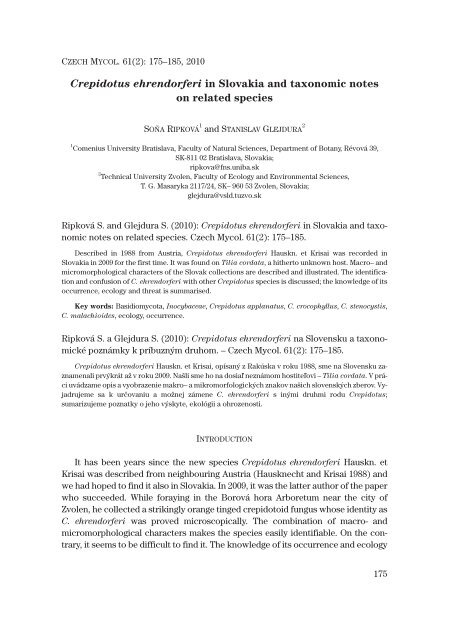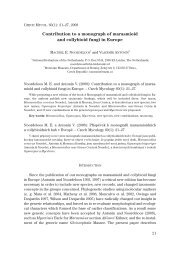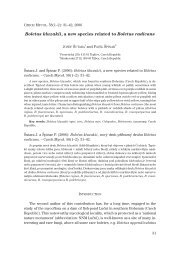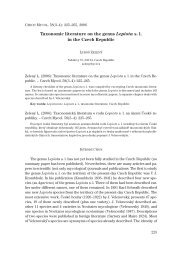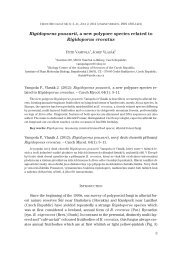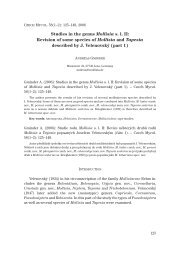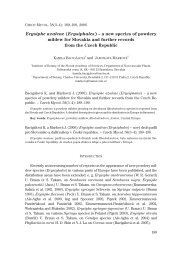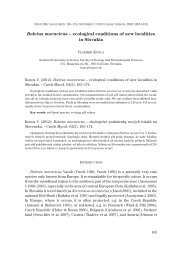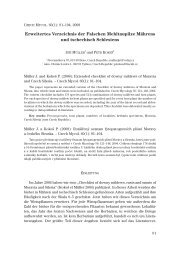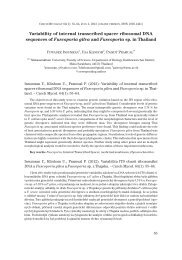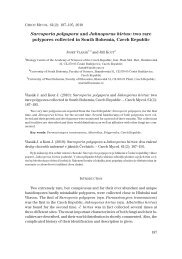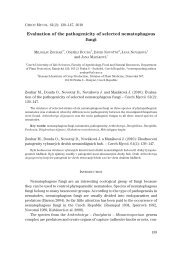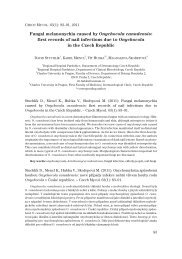Crepidotus ehrendorferi in Slovakia and taxonomic notes on related ...
Crepidotus ehrendorferi in Slovakia and taxonomic notes on related ...
Crepidotus ehrendorferi in Slovakia and taxonomic notes on related ...
Create successful ePaper yourself
Turn your PDF publications into a flip-book with our unique Google optimized e-Paper software.
CZECH MYCOL. 61(2): 175–185, 2010is poor not <strong>on</strong>ly <str<strong>on</strong>g>in</str<strong>on</strong>g> <str<strong>on</strong>g>Slovakia</str<strong>on</strong>g>, but <str<strong>on</strong>g>in</str<strong>on</strong>g> the whole of Europe (C<strong>on</strong>siglio <str<strong>on</strong>g>and</str<strong>on</strong>g> Setti 2008).The aim of our paper is therefore to present the Slovak collecti<strong>on</strong>s of C. <str<strong>on</strong>g>ehrendorferi</str<strong>on</strong>g>,extend<str<strong>on</strong>g>in</str<strong>on</strong>g>g its distributi<strong>on</strong> area. We have also <str<strong>on</strong>g>in</str<strong>on</strong>g>cluded descripti<strong>on</strong>s ofmacro– <str<strong>on</strong>g>and</str<strong>on</strong>g> micromorphological characters <str<strong>on</strong>g>and</str<strong>on</strong>g> ecological characteristics.MATERIAL AND METHODSThe study is based <strong>on</strong> the exam<str<strong>on</strong>g>in</str<strong>on</strong>g>ati<strong>on</strong> of eight collecti<strong>on</strong>s of <str<strong>on</strong>g>Crepidotus</str<strong>on</strong>g><str<strong>on</strong>g>ehrendorferi</str<strong>on</strong>g> (c. 20 fruitbodies <str<strong>on</strong>g>in</str<strong>on</strong>g> all development stages) found at <strong>on</strong>e site with anarea of about 20 × 40 m, <strong>on</strong> five branches <str<strong>on</strong>g>and</str<strong>on</strong>g> trunks ly<str<strong>on</strong>g>in</str<strong>on</strong>g>g at 3–20 m from eachother. The specimens are kept <str<strong>on</strong>g>in</str<strong>on</strong>g> S. Glejdura’s private herbarium <str<strong>on</strong>g>and</str<strong>on</strong>g> <str<strong>on</strong>g>in</str<strong>on</strong>g> SLO. Theabbreviati<strong>on</strong> of S. Glejdura’s herbarium is PSG, the abbreviati<strong>on</strong> of the SLO herbariumis cited <str<strong>on</strong>g>in</str<strong>on</strong>g> accordance with the Index Herbariorum (Holmgren et al. 1990).Data <strong>on</strong> voucher specimens are presented <str<strong>on</strong>g>in</str<strong>on</strong>g> their orig<str<strong>on</strong>g>in</str<strong>on</strong>g>al form.The macromorphological characters were observed <strong>on</strong> fresh material, themicromorphological characters <str<strong>on</strong>g>in</str<strong>on</strong>g> dried material under an Olympus BX41 lightmicroscope with an oil immersi<strong>on</strong> lens. The microscopical mounts were preparedwith a 5% aqueous soluti<strong>on</strong> of KOH <str<strong>on</strong>g>and</str<strong>on</strong>g> a soluti<strong>on</strong> of C<strong>on</strong>go Red <str<strong>on</strong>g>in</str<strong>on</strong>g> amm<strong>on</strong>ia (1 mlof 25% amm<strong>on</strong>ia added <str<strong>on</strong>g>in</str<strong>on</strong>g> a filtrated soluti<strong>on</strong> of 1.5 g of C<strong>on</strong>go Red <str<strong>on</strong>g>in</str<strong>on</strong>g> 50 ml of distilledwater). The colours of microstructures were exam<str<strong>on</strong>g>in</str<strong>on</strong>g>ed <str<strong>on</strong>g>in</str<strong>on</strong>g> KOH; the measurementswere made <str<strong>on</strong>g>in</str<strong>on</strong>g> C<strong>on</strong>go Red. For the measurements (30 per specimen;three specimens were measured: SLO 707, PSG 8/78, PSG 8/81) of microcharacters(spores, cheilocystidia, basidia <str<strong>on</strong>g>and</str<strong>on</strong>g> term<str<strong>on</strong>g>in</str<strong>on</strong>g>al cells of pileipellis) m<str<strong>on</strong>g>in</str<strong>on</strong>g>imum,maximum (<str<strong>on</strong>g>in</str<strong>on</strong>g> parentheses) <str<strong>on</strong>g>and</str<strong>on</strong>g> average ± st<str<strong>on</strong>g>and</str<strong>on</strong>g>ard deviati<strong>on</strong> values are presented.Abbreviati<strong>on</strong>s: L = number of lamellae reach<str<strong>on</strong>g>in</str<strong>on</strong>g>g the stipe, l = number oflamellulae between each pair of lamellae, Q = ratio of length <str<strong>on</strong>g>and</str<strong>on</strong>g> width of spores.References to colours of macromorphological characters follow Kornerup <str<strong>on</strong>g>and</str<strong>on</strong>g>Wanscher (1974). Descriptive term<str<strong>on</strong>g>in</str<strong>on</strong>g>ology follows Vell<str<strong>on</strong>g>in</str<strong>on</strong>g>ga (1988). The nomenclatureof vascular plants is based <strong>on</strong> the work by Marhold (1998). The name of thevegetati<strong>on</strong> type follows Hanč<str<strong>on</strong>g>in</str<strong>on</strong>g>ský (1972). The <str<strong>on</strong>g>tax<strong>on</strong>omic</str<strong>on</strong>g>al c<strong>on</strong>cept of the genus<str<strong>on</strong>g>Crepidotus</str<strong>on</strong>g> is based <strong>on</strong> works by Senn-Irlet (1995), Pouzar (2005b) <str<strong>on</strong>g>and</str<strong>on</strong>g> C<strong>on</strong>siglio<str<strong>on</strong>g>and</str<strong>on</strong>g> Setti (2008).RESULTS AND DISCUSSION<str<strong>on</strong>g>Crepidotus</str<strong>on</strong>g> <str<strong>on</strong>g>ehrendorferi</str<strong>on</strong>g> Hauskn. et Krisai, Pl. Syst. Evol. 161: 183, 1988H o l o t y p e. Austria: V<str<strong>on</strong>g>in</str<strong>on</strong>g>dob<strong>on</strong>a (Vienna), <str<strong>on</strong>g>in</str<strong>on</strong>g> silva “La<str<strong>on</strong>g>in</str<strong>on</strong>g>zer Tiergarten” nom<str<strong>on</strong>g>in</str<strong>on</strong>g>ata:<str<strong>on</strong>g>in</str<strong>on</strong>g> m<strong>on</strong>te Bärenberg dicto, 1. 9. 1986, leg. E. Mrazek, WU 6554.176
RIPKOVÁ S. AND GLEJDURA S.: CREPIDOTUS EHRENDORFERI IN SLOVAKIAFig. 1. <str<strong>on</strong>g>Crepidotus</str<strong>on</strong>g> <str<strong>on</strong>g>ehrendorferi</str<strong>on</strong>g>: juvenile basidiocarp (PSG 8/77). Photo by S. Glejdura.Fig. 2. <str<strong>on</strong>g>Crepidotus</str<strong>on</strong>g> <str<strong>on</strong>g>ehrendorferi</str<strong>on</strong>g>: adult basidiocarps (PSG 8/78). Photo by S. Glejdura.Fig. 3. <str<strong>on</strong>g>Crepidotus</str<strong>on</strong>g> <str<strong>on</strong>g>ehrendorferi</str<strong>on</strong>g>: old basidiocarp (PSG 8/77). Photo by S. Glejdura.177
CZECH MYCOL. 61(2): 175–185, 2010Fig. 4. <str<strong>on</strong>g>Crepidotus</str<strong>on</strong>g> <str<strong>on</strong>g>ehrendorferi</str<strong>on</strong>g>: a – cheilocystidia, b – spores, c – basidia, d – term<str<strong>on</strong>g>in</str<strong>on</strong>g>al cells ofpileipellis (SLO 707). Scale bar = 10 μm.178
RIPKOVÁ S. AND GLEJDURA S.: CREPIDOTUS EHRENDORFERI IN SLOVAKIAD e s c r i p t i o n. B a s i d i o c a r p s (Figs. 1–3) grow<str<strong>on</strong>g>in</str<strong>on</strong>g>g solitary or <str<strong>on</strong>g>in</str<strong>on</strong>g> smallgroups. P i l e u s 15–50 × 10–35 mm, irregularly circular, flabelliform, roundedflabelliform or reniform, plano-c<strong>on</strong>vex; marg<str<strong>on</strong>g>in</str<strong>on</strong>g> <str<strong>on</strong>g>in</str<strong>on</strong>g>flexed, straight, becom<str<strong>on</strong>g>in</str<strong>on</strong>g>gslightly undate when old; juvenile light orange (5A4-5) to salm<strong>on</strong> (6A4), turn<str<strong>on</strong>g>in</str<strong>on</strong>g>gpale orange (5A3) to orange white (5A2) with age; similar <str<strong>on</strong>g>in</str<strong>on</strong>g> colour, surface at firstvelut<str<strong>on</strong>g>in</str<strong>on</strong>g>ous, later glabrous, somewhat translucently striate at marg<str<strong>on</strong>g>in</str<strong>on</strong>g> when old <str<strong>on</strong>g>and</str<strong>on</strong>g>wet, with whitish tomentum at po<str<strong>on</strong>g>in</str<strong>on</strong>g>t of attachment; slightly hygrophanous. S t i p e<strong>on</strong>ly visible when young, later vanish<str<strong>on</strong>g>in</str<strong>on</strong>g>g <str<strong>on</strong>g>and</str<strong>on</strong>g> basidiocarps attached to the substratumlaterally or dorsally, 1.5–3 mm l<strong>on</strong>g, 1–1.5 mm wide, excentric to lateral, cyl<str<strong>on</strong>g>in</str<strong>on</strong>g>drical,slightly curved, light orange (5A4-5) to brownish orange (6C8), the oranget<str<strong>on</strong>g>in</str<strong>on</strong>g>t dist<str<strong>on</strong>g>in</str<strong>on</strong>g>ct also <str<strong>on</strong>g>in</str<strong>on</strong>g> old <str<strong>on</strong>g>and</str<strong>on</strong>g> dry basidiocarps, velut<str<strong>on</strong>g>in</str<strong>on</strong>g>ous. C o n t e x t 2–3 mm, thickestbelow the po<str<strong>on</strong>g>in</str<strong>on</strong>g>t of attachment, when young salm<strong>on</strong> (6A4), later light orange(5A4), but <strong>on</strong>ly under pileus surface, otherwise fad<str<strong>on</strong>g>in</str<strong>on</strong>g>g to orange white (5A2) orcream (4A3), or cream all over; taste mild to somewhat bitter after a while; smell<str<strong>on</strong>g>in</str<strong>on</strong>g>dist<str<strong>on</strong>g>in</str<strong>on</strong>g>ct. L a m e l l a e L = 14–39, l = 3, up to 6 mm wide, adnexed, pale orange(5A3), orange white (5A2) to cream (4A3) when young, at maturity light brown(5D4) to clay (5D5), edge fimbriate, whitish. Spore pr<str<strong>on</strong>g>in</str<strong>on</strong>g>t greyish brown (5D5).Spores(5–)5.8–7.7(–9.7) × (5.2–)5.9–7.8(–9.7) μm, Q = (0.92–)0.97–1.02(–1.05),globose, punctate under light microscope, yellowish to brown-yellowish <str<strong>on</strong>g>in</str<strong>on</strong>g> KOH.B a s i d i a 4-spored, (22–)25.7–31.9(–35) × (6–)7.2–8.6(–9) μm, clavate, hyal<str<strong>on</strong>g>in</str<strong>on</strong>g>e,th<str<strong>on</strong>g>in</str<strong>on</strong>g>-walled. C h e i l o c y s t i d i a (24–)33.6–59.2(–78) × (4.5–)5.1–7.5(–10.5) μm,mostly cyl<str<strong>on</strong>g>in</str<strong>on</strong>g>drical <str<strong>on</strong>g>and</str<strong>on</strong>g> flexuous, less often utriform or clavate, rarely septate; atthe tips mostly tapered, less frequently obtuse, often branched, i.e. forked or antler-like,hyal<str<strong>on</strong>g>in</str<strong>on</strong>g>e, th<str<strong>on</strong>g>in</str<strong>on</strong>g>-walled. P i l e i p e l l i s a trichoderm of 4–10 μm wide hyphae;term<str<strong>on</strong>g>in</str<strong>on</strong>g>al cells (39–)43.2–63.1(–82) × (4–)5.5–7.1(–9) μm, narrowly c<strong>on</strong>ical, cyl<str<strong>on</strong>g>in</str<strong>on</strong>g>dricalor flexuous; <str<strong>on</strong>g>in</str<strong>on</strong>g> the upper part mostly tapered, some forked, unseptate,hyal<str<strong>on</strong>g>in</str<strong>on</strong>g>e, th<str<strong>on</strong>g>in</str<strong>on</strong>g>-walled. C l a m p c o n n e c t i o n s present <str<strong>on</strong>g>in</str<strong>on</strong>g> all tissues (Fig. 4).P u b l i s h e d f i g u r e s a n d / o r d e s c r i p t i o n s. Hausknecht <str<strong>on</strong>g>and</str<strong>on</strong>g> Krisai(1988), Cetto (1993), Senn-Irlet (1995), C<strong>on</strong>siglio <str<strong>on</strong>g>and</str<strong>on</strong>g> Setti (2008).Material studiedS l o v a k i a, Zvolenská kotl<str<strong>on</strong>g>in</str<strong>on</strong>g>a Bas<str<strong>on</strong>g>in</str<strong>on</strong>g>, Borová hora Arboretum, c. 3 km N of the city centre ofZvolen, alt. 298 m, NNW-fac<str<strong>on</strong>g>in</str<strong>on</strong>g>g slope, coord. 48° 35' 56.03" N, 19° 8' 0.85" E, Tilieto-Aceretum <str<strong>on</strong>g>in</str<strong>on</strong>g>feriora,<strong>on</strong> bark <str<strong>on</strong>g>and</str<strong>on</strong>g> wood of fallen decay<str<strong>on</strong>g>in</str<strong>on</strong>g>g branch of Tilia cordata, 11 Sep 2009, leg. S. Glejdura (PSG 8/76).Ibid., <strong>on</strong> wood of decay<str<strong>on</strong>g>in</str<strong>on</strong>g>g fallen branch of Tilia cordata, 13 Sep 2009 (PSG 8/77). Ibid., <strong>on</strong> wood of decay<str<strong>on</strong>g>in</str<strong>on</strong>g>gfallen branch of Tilia cordata, 18 Sep 2009 (PSG 8/78). Ibid., <strong>on</strong> wood of decay<str<strong>on</strong>g>in</str<strong>on</strong>g>g fallen branchof Tilia cordata, 28 Sep 2009, leg. S. Ripková (SLO 707). Ibid., <strong>on</strong> wood of decay<str<strong>on</strong>g>in</str<strong>on</strong>g>g fallen branch ofTilia cordata, 26 Oct 2009 (PSG 8/79). Ibid., <strong>on</strong> wood of decay<str<strong>on</strong>g>in</str<strong>on</strong>g>g fallen trunk of Tilia cordata, 3 Nov2009 (PSG 8/80). Ibid., <strong>on</strong> wood of decay<str<strong>on</strong>g>in</str<strong>on</strong>g>g st<str<strong>on</strong>g>and</str<strong>on</strong>g><str<strong>on</strong>g>in</str<strong>on</strong>g>g branch (branch grow<str<strong>on</strong>g>in</str<strong>on</strong>g>g from fallen trunk) ofTilia cordata, 5 Nov 2009 (PSG 8/81). Ibid., <strong>on</strong> wood of decay<str<strong>on</strong>g>in</str<strong>on</strong>g>g fallen trunk of Tilia cordata, 19 Nov2009 (PSG 8/82).179
CZECH MYCOL. 61(2): 175–185, 2010EcologyBorová hora Arboretum – the locality of <str<strong>on</strong>g>Crepidotus</str<strong>on</strong>g> <str<strong>on</strong>g>ehrendorferi</str<strong>on</strong>g> <str<strong>on</strong>g>in</str<strong>on</strong>g> <str<strong>on</strong>g>Slovakia</str<strong>on</strong>g> –is a research <str<strong>on</strong>g>and</str<strong>on</strong>g> development site of the Technical University <str<strong>on</strong>g>in</str<strong>on</strong>g> Zvolen. It representsan important collecti<strong>on</strong> of trees which orig<str<strong>on</strong>g>in</str<strong>on</strong>g>ally grew <str<strong>on</strong>g>in</str<strong>on</strong>g> natural forests of<str<strong>on</strong>g>Slovakia</str<strong>on</strong>g> (approx. 1500 taxa – species <str<strong>on</strong>g>and</str<strong>on</strong>g> <str<strong>on</strong>g>in</str<strong>on</strong>g>fraspecific taxa), as well as a collecti<strong>on</strong>of roses (approx. 600 taxa) <str<strong>on</strong>g>and</str<strong>on</strong>g> cacti (approx. 600 taxa). The Arboretum wasfounded <str<strong>on</strong>g>in</str<strong>on</strong>g> 1965, designated a Protected Site <str<strong>on</strong>g>in</str<strong>on</strong>g> 1981 <str<strong>on</strong>g>and</str<strong>on</strong>g> has currently an area of47.84 ha (Lukáčik et al. 2005).Besides mostly planted <str<strong>on</strong>g>and</str<strong>on</strong>g> n<strong>on</strong>-native trees, there are also some remnants ofnatural vegetati<strong>on</strong> <str<strong>on</strong>g>in</str<strong>on</strong>g> the Arboretum. An example of such vegetati<strong>on</strong> type isTilieto-Aceretum <str<strong>on</strong>g>in</str<strong>on</strong>g>feriora cover<str<strong>on</strong>g>in</str<strong>on</strong>g>g an estimated area of 2 ha – the collect<str<strong>on</strong>g>in</str<strong>on</strong>g>g siteof C. <str<strong>on</strong>g>ehrendorferi</str<strong>on</strong>g> (Greštiak 1975, Križová 1985). The tree layer is ma<str<strong>on</strong>g>in</str<strong>on</strong>g>ly formedby Tilia cordata, Quercus robur <str<strong>on</strong>g>and</str<strong>on</strong>g> Acer campestre. These are up to 100-year-oldtrees. In the vic<str<strong>on</strong>g>in</str<strong>on</strong>g>ity of the collect<str<strong>on</strong>g>in</str<strong>on</strong>g>g site of C. <str<strong>on</strong>g>ehrendorferi</str<strong>on</strong>g>, the Tilia <str<strong>on</strong>g>and</str<strong>on</strong>g>Quercus trees were mostly 60 years old <str<strong>on</strong>g>and</str<strong>on</strong>g> Acer trees 20 years old. The shrublayer is species rich, ma<str<strong>on</strong>g>in</str<strong>on</strong>g>ly represented by Corylus avellana, Ribes sp., Rubussp., Sambucus nigra, <str<strong>on</strong>g>and</str<strong>on</strong>g> Swida sangu<str<strong>on</strong>g>in</str<strong>on</strong>g>ea. The herb layer is composed ofAegopodium podagraria, Asarum europaeum, Galeobdol<strong>on</strong> luteum, Geraniumsp., Mercurialis perennis, L<strong>on</strong>icera xylosteum, Stellaria holostea, Pulm<strong>on</strong>ariaobscura, <str<strong>on</strong>g>and</str<strong>on</strong>g> some other species (the checklist of taxa is based <strong>on</strong> an autumnrelevé). The bedrock is formed by travert<str<strong>on</strong>g>in</str<strong>on</strong>g>es or travert<str<strong>on</strong>g>in</str<strong>on</strong>g>e slopes with an admixtureof loess or quartzose gravels; the soil is represented by typical pararendz<str<strong>on</strong>g>in</str<strong>on</strong>g>awith travert<str<strong>on</strong>g>in</str<strong>on</strong>g>e. The mean annual precipitati<strong>on</strong> is 640 mm, the mean annual temperature8.8 °C. The altitude is 298 m, <str<strong>on</strong>g>and</str<strong>on</strong>g> the slope orientati<strong>on</strong> north-northwestern(Obr 1975, Lukáčik et al. 2005).C. <str<strong>on</strong>g>ehrendorferi</str<strong>on</strong>g> produced basidiocarps <strong>on</strong> wood <str<strong>on</strong>g>and</str<strong>on</strong>g> bark of dead decay<str<strong>on</strong>g>in</str<strong>on</strong>g>gbranches (diam. 2.5–4 cm) <str<strong>on</strong>g>and</str<strong>on</strong>g> trunks (diam. up to 11 cm) of Tilia cordatawhich were a part of heaps after cutt<str<strong>on</strong>g>in</str<strong>on</strong>g>g; three trees were cut <str<strong>on</strong>g>and</str<strong>on</strong>g> the site becamemore lighted. Most basidiocarps were recorded <strong>on</strong> woody substrates ly<str<strong>on</strong>g>in</str<strong>on</strong>g>g directly<strong>on</strong> the soil or ly<str<strong>on</strong>g>in</str<strong>on</strong>g>g <str<strong>on</strong>g>in</str<strong>on</strong>g> the heap approx. 60 cm above the ground; <str<strong>on</strong>g>in</str<strong>on</strong>g> <strong>on</strong>e casethe basidiocarps grew freely above the ground at a height of approx. 170 cm (<strong>on</strong>a branch protrud<str<strong>on</strong>g>in</str<strong>on</strong>g>g from a fallen trunk). No other fungi shared the same substrateswith C. <str<strong>on</strong>g>ehrendorferi</str<strong>on</strong>g>. Although fructify<str<strong>on</strong>g>in</str<strong>on</strong>g>g <str<strong>on</strong>g>in</str<strong>on</strong>g> the same period <str<strong>on</strong>g>and</str<strong>on</strong>g> <str<strong>on</strong>g>in</str<strong>on</strong>g> the vic<str<strong>on</strong>g>in</str<strong>on</strong>g>ityof C. <str<strong>on</strong>g>ehrendorferi</str<strong>on</strong>g>, the species Ascocoryne cylichnium (Tul.) Korf,Holwaya mucida (Schulzer) Korf et Abawi <str<strong>on</strong>g>and</str<strong>on</strong>g> Peziza cf. granularis D<strong>on</strong>ad<str<strong>on</strong>g>in</str<strong>on</strong>g>igrew <strong>on</strong> other parts of Tilia cordata wood. We observed the producti<strong>on</strong> ofbasidiocarps from September to November. It is <str<strong>on</strong>g>in</str<strong>on</strong>g>terest<str<strong>on</strong>g>in</str<strong>on</strong>g>g to add that it was the<strong>on</strong>ly site with such a c<strong>on</strong>centrati<strong>on</strong> of ly<str<strong>on</strong>g>in</str<strong>on</strong>g>g wood. Although there were someother fallen trees (not cut) with<str<strong>on</strong>g>in</str<strong>on</strong>g> the vegetati<strong>on</strong> type, n<strong>on</strong>e of them was col<strong>on</strong>isedby C. <str<strong>on</strong>g>ehrendorferi</str<strong>on</strong>g> basidiocarps.180
RIPKOVÁ S. AND GLEJDURA S.: CREPIDOTUS EHRENDORFERI IN SLOVAKIASumm<str<strong>on</strong>g>in</str<strong>on</strong>g>g up the ecological data from the literature, C. <str<strong>on</strong>g>ehrendorferi</str<strong>on</strong>g> is a saprotroph,produc<str<strong>on</strong>g>in</str<strong>on</strong>g>g basidiocarps <strong>on</strong> decay<str<strong>on</strong>g>in</str<strong>on</strong>g>g trunks of Fagus sylvatica (Hausknecht<str<strong>on</strong>g>and</str<strong>on</strong>g> Krisai 1988, Horak 2005, Cetto 1993, C<strong>on</strong>siglio <str<strong>on</strong>g>and</str<strong>on</strong>g> Setti 2008) <str<strong>on</strong>g>and</str<strong>on</strong>g> probably ofPopulus sp. (C<strong>on</strong>siglio <str<strong>on</strong>g>and</str<strong>on</strong>g> Setti 2008) from June to October (Hausknecht <str<strong>on</strong>g>and</str<strong>on</strong>g>Krisai 1988). More detailed characteristics of the habitat of C. <str<strong>on</strong>g>ehrendorferi</str<strong>on</strong>g> is <str<strong>on</strong>g>in</str<strong>on</strong>g>cluded<strong>on</strong>ly by Hausknecht <str<strong>on</strong>g>and</str<strong>on</strong>g> Krisai (1988), i.e. deciduous (Fagus, Quercus) primeval-likeforest with many old trees (the forest is a part of the Viennese La<str<strong>on</strong>g>in</str<strong>on</strong>g>zerTiergarten Nature Reserve).Threat. <str<strong>on</strong>g>Crepidotus</str<strong>on</strong>g> <str<strong>on</strong>g>ehrendorferi</str<strong>on</strong>g> is classified as endangered <str<strong>on</strong>g>in</str<strong>on</strong>g> Austria(Krisai-Greilhuber 1999), Switzerl<str<strong>on</strong>g>and</str<strong>on</strong>g> (Senn-Irlet et al. 2007) <str<strong>on</strong>g>and</str<strong>on</strong>g> France (Moreaupers. comm.).Identity of <str<strong>on</strong>g>Crepidotus</str<strong>on</strong>g> <str<strong>on</strong>g>ehrendorferi</str<strong>on</strong>g>Compar<str<strong>on</strong>g>in</str<strong>on</strong>g>g our observati<strong>on</strong>s of C. <str<strong>on</strong>g>ehrendorferi</str<strong>on</strong>g> with the published <strong>on</strong>es(Hausknecht <str<strong>on</strong>g>and</str<strong>on</strong>g> Krisai 1988, C<strong>on</strong>siglio <str<strong>on</strong>g>and</str<strong>on</strong>g> Setti 2008), we did not f<str<strong>on</strong>g>in</str<strong>on</strong>g>d dist<str<strong>on</strong>g>in</str<strong>on</strong>g>ctdifferences <str<strong>on</strong>g>in</str<strong>on</strong>g> cheilocystidia. On the other h<str<strong>on</strong>g>and</str<strong>on</strong>g>, the spores measured <str<strong>on</strong>g>in</str<strong>on</strong>g> our materialare larger. Even the average <str<strong>on</strong>g>and</str<strong>on</strong>g> st<str<strong>on</strong>g>and</str<strong>on</strong>g>ard deviati<strong>on</strong> values exceed 7 μm. Theratio of length <str<strong>on</strong>g>and</str<strong>on</strong>g> width of spores (Q) does not exceed the value of 1.05. This iswhy we have described the shape of spores as globose, c<strong>on</strong>trary to C<strong>on</strong>siglio <str<strong>on</strong>g>and</str<strong>on</strong>g>Setti (2008), who described the spores as globose to subglobose with Q up to 1.12.The pileipellis, although described by C<strong>on</strong>siglio <str<strong>on</strong>g>and</str<strong>on</strong>g> Setti (2008) as a cutis transiti<strong>on</strong>alto a trichoderm, is a dist<str<strong>on</strong>g>in</str<strong>on</strong>g>ct trichoderm <str<strong>on</strong>g>in</str<strong>on</strong>g> our material. The shape of theterm<str<strong>on</strong>g>in</str<strong>on</strong>g>al cells that we have observed fit well to what is illustrated by Hausknecht<str<strong>on</strong>g>and</str<strong>on</strong>g> Krisai (1988) as well as C<strong>on</strong>siglio <str<strong>on</strong>g>and</str<strong>on</strong>g> Setti (2008). However, we have not observedany pigmentati<strong>on</strong> of the term<str<strong>on</strong>g>in</str<strong>on</strong>g>al cells of pileipellis, as presented byC<strong>on</strong>siglio <str<strong>on</strong>g>and</str<strong>on</strong>g> Setti (2008) (Tab. 1). In spite of the above menti<strong>on</strong>ed differences <str<strong>on</strong>g>in</str<strong>on</strong>g>micromorphology of C. <str<strong>on</strong>g>ehrendorferi</str<strong>on</strong>g>, we do not c<strong>on</strong>sider them to support a newtax<strong>on</strong>, but <strong>on</strong>ly to dem<strong>on</strong>strate the species’ variability.Comparis<strong>on</strong> of <str<strong>on</strong>g>Crepidotus</str<strong>on</strong>g> <str<strong>on</strong>g>ehrendorferi</str<strong>on</strong>g> with species of similar spore morphologyIt is the strik<str<strong>on</strong>g>in</str<strong>on</strong>g>g orange t<str<strong>on</strong>g>in</str<strong>on</strong>g>ge <strong>on</strong> the basidiomata of <str<strong>on</strong>g>Crepidotus</str<strong>on</strong>g> <str<strong>on</strong>g>ehrendorferi</str<strong>on</strong>g>which led some authors, e.g. Hausknecht <str<strong>on</strong>g>and</str<strong>on</strong>g> Krisai (1988), Ripková (2002),Horak (2005), <str<strong>on</strong>g>and</str<strong>on</strong>g> C<strong>on</strong>siglio <str<strong>on</strong>g>and</str<strong>on</strong>g> Setti (2008), to compare the species with othersimilarly coloured European <str<strong>on</strong>g>Crepidotus</str<strong>on</strong>g> species, such as C. crocophyllus (Berk.)Sacc. <str<strong>on</strong>g>and</str<strong>on</strong>g> C. maced<strong>on</strong>icus Pilát. However, the tax<strong>on</strong>omy of <str<strong>on</strong>g>Crepidotus</str<strong>on</strong>g> is alsobased <strong>on</strong> microscopical characters, namely spore shape <str<strong>on</strong>g>and</str<strong>on</strong>g> ornamentati<strong>on</strong> (B<str<strong>on</strong>g>and</str<strong>on</strong>g>ala<str<strong>on</strong>g>and</str<strong>on</strong>g> M<strong>on</strong>toya 2004, Senn-Irlet 1995). We therefore compared C. <str<strong>on</strong>g>ehrendorferi</str<strong>on</strong>g> alsowith species of similar spore morphology.181
CZECH MYCOL. 61(2): 175–185, 2010Tab. 1. Comparis<strong>on</strong> of spores, cheilocystidia <str<strong>on</strong>g>and</str<strong>on</strong>g> pileipellis of <str<strong>on</strong>g>Crepidotus</str<strong>on</strong>g> <str<strong>on</strong>g>ehrendorferi</str<strong>on</strong>g>. Data areshortened.data sourcespore size cheilocystidia size <str<strong>on</strong>g>and</str<strong>on</strong>g> shape pileipellis characteristicsHausknecht <str<strong>on</strong>g>and</str<strong>on</strong>g> Krisai(1988)(4.7–)6–6.5(–7) µmC<strong>on</strong>siglio <str<strong>on</strong>g>and</str<strong>on</strong>g> Setti (2008)5.8–6.9 × 5.5–6.6 µmQ = 0.98–1.12Our observati<strong>on</strong>s(5–)5.8–7.7(–9.7) ×(5.2–)5.9–7.8(–9.7) µmQ = (0.92–)0.97–1.02(–1.05)28–63 × 4–9 µm;flexuous-c<strong>on</strong>torted, sometimesforked, knobbed34–55 × 5.0–7.6 µm;cyl<str<strong>on</strong>g>in</str<strong>on</strong>g>drical, lageniform,subfusoid, often apically tapered,flexuous, strangulated(24–)33.6–59.2(–78) ×(4.5–)5.1–7.5(–10.5) µm;cyl<str<strong>on</strong>g>in</str<strong>on</strong>g>drical, flexuous, lessutriform, clavate, rarely septate;at the tips tapered, less obtuse,often forked or antler-likea trichoderm made of th<str<strong>on</strong>g>in</str<strong>on</strong>g>-walled, unseptate,erect, sub-regularly arranged, 6–9 µm thickhyphaea cutis of smooth, cyl<str<strong>on</strong>g>in</str<strong>on</strong>g>drical, <str<strong>on</strong>g>in</str<strong>on</strong>g>terwoven, 3–12 µmwide hyphae, with variably erect term<str<strong>on</strong>g>in</str<strong>on</strong>g>al cells,up to 12 µm wide, transiti<strong>on</strong>al to a trichoderm,with ± deep brown <str<strong>on</strong>g>in</str<strong>on</strong>g>tracellular pigment, somehyphae with f<str<strong>on</strong>g>in</str<strong>on</strong>g>e pigment encrust<str<strong>on</strong>g>in</str<strong>on</strong>g>g the outer walla trichoderm of 4–10 µm wide hyphae, term<str<strong>on</strong>g>in</str<strong>on</strong>g>alcells (39–)43.2–63.1(–82) × (4–)5.5–7.1(–9)µm, narrowly c<strong>on</strong>ical, cyl<str<strong>on</strong>g>in</str<strong>on</strong>g>drical or flexuous; <str<strong>on</strong>g>in</str<strong>on</strong>g>the upper part mostly tapered, some forked,unseptate, hyal<str<strong>on</strong>g>in</str<strong>on</strong>g>e, th<str<strong>on</strong>g>in</str<strong>on</strong>g>-walledC. <str<strong>on</strong>g>ehrendorferi</str<strong>on</strong>g> bel<strong>on</strong>gs to the group of four other hitherto known <str<strong>on</strong>g>Crepidotus</str<strong>on</strong>g>species <str<strong>on</strong>g>in</str<strong>on</strong>g> Europe hav<str<strong>on</strong>g>in</str<strong>on</strong>g>g globose or subglobose spores: C. applanatus (Pers.)P. Kumm., C. crocophyllus, C. stenocystis Pouzar, <str<strong>on</strong>g>and</str<strong>on</strong>g> C. malachioides C<strong>on</strong>siglio,Prydiuk et Setti. Follow<str<strong>on</strong>g>in</str<strong>on</strong>g>g the term<str<strong>on</strong>g>in</str<strong>on</strong>g>ology by Vell<str<strong>on</strong>g>in</str<strong>on</strong>g>ga (1988), globose sporeshave Q = 0.95–1.05, subglobose <strong>on</strong>es Q = 1.05–1.15 (Tab. 2). There are also otherEuropean species produc<str<strong>on</strong>g>in</str<strong>on</strong>g>g globose to subglobose spores, such as C. carpaticusPilát, C. cristatus Senn-Irlet et Immerzeel, C. c<str<strong>on</strong>g>in</str<strong>on</strong>g>nabar<str<strong>on</strong>g>in</str<strong>on</strong>g>us Peck <str<strong>on</strong>g>and</str<strong>on</strong>g> C. cesatii(Rabenh.) Sacc. However, these species produce also broadly ellipsoid sporeswith Q 1.15–1.3 (cf. Senn-Irlet 1995, Senn-Irlet <str<strong>on</strong>g>and</str<strong>on</strong>g> Immerzeel 2003), which easilydist<str<strong>on</strong>g>in</str<strong>on</strong>g>guishes them from the five above-menti<strong>on</strong>ed species.Hav<str<strong>on</strong>g>in</str<strong>on</strong>g>g a similar globose to subglobose spore shape as well as baculate sporeornamentati<strong>on</strong> observed under a scann<str<strong>on</strong>g>in</str<strong>on</strong>g>g electr<strong>on</strong> microscope (SEM) (Senn-Irlet1995, C<strong>on</strong>siglio <str<strong>on</strong>g>and</str<strong>on</strong>g> Setti 2008), the delimitati<strong>on</strong> of C. <str<strong>on</strong>g>ehrendorferi</str<strong>on</strong>g>, C. applanatus,C. crocophyllus, C. stenocystis, <str<strong>on</strong>g>and</str<strong>on</strong>g> C. malachioides is further based <strong>on</strong> charactersof pileipellis <str<strong>on</strong>g>and</str<strong>on</strong>g> cheilocystidia. As shown <str<strong>on</strong>g>in</str<strong>on</strong>g> Tab. 2, C. <str<strong>on</strong>g>ehrendorferi</str<strong>on</strong>g> is easilydist<str<strong>on</strong>g>in</str<strong>on</strong>g>guishable from the other species by a characteristic type of pileipellis, i.e.a trichoderm. C. malachioides also has a unique pileipellis, i.e. composed ofcapitate pileocystidia form<str<strong>on</strong>g>in</str<strong>on</strong>g>g a hymeniderm. With<str<strong>on</strong>g>in</str<strong>on</strong>g> the species with a cutis,C. applanatus, C. crocophyllus <str<strong>on</strong>g>and</str<strong>on</strong>g> C. stenocystis, <strong>on</strong>ly C. crocophyllus has<str<strong>on</strong>g>in</str<strong>on</strong>g>crusted <str<strong>on</strong>g>and</str<strong>on</strong>g> coloured hyphae <str<strong>on</strong>g>and</str<strong>on</strong>g> thick-walled term<str<strong>on</strong>g>in</str<strong>on</strong>g>al cells. The last two specieshave different cheilocystidia: C. applanatus has mostly capitate cheilocystidia,whereas C. stenocystis has lageniform <strong>on</strong>es (Pouzar 2005a).182
RIPKOVÁ S. AND GLEJDURA S.: CREPIDOTUS EHRENDORFERI IN SLOVAKIABesides <str<strong>on</strong>g>in</str<strong>on</strong>g>clud<str<strong>on</strong>g>in</str<strong>on</strong>g>g C. carpaticus, C. applanatus, C. crocophyllus <str<strong>on</strong>g>and</str<strong>on</strong>g> C. <str<strong>on</strong>g>ehrendorferi</str<strong>on</strong>g><str<strong>on</strong>g>in</str<strong>on</strong>g>to the secti<strong>on</strong> Sphaerula sensu Hesler <str<strong>on</strong>g>and</str<strong>on</strong>g> Smith (1965), i.e. am<strong>on</strong>g the<str<strong>on</strong>g>Crepidotus</str<strong>on</strong>g> taxa with globose to subglobose <str<strong>on</strong>g>and</str<strong>on</strong>g> verrucose spores, C<strong>on</strong>siglio <str<strong>on</strong>g>and</str<strong>on</strong>g>Setti (2008) <str<strong>on</strong>g>in</str<strong>on</strong>g>cluded also the newly described C. malachioides <str<strong>on</strong>g>and</str<strong>on</strong>g> the NorthAmerican taxa C. malachius (Berk. et M. A. Curtis) Sacc. var. malachius <str<strong>on</strong>g>and</str<strong>on</strong>g>C. malachius var. trichifer Hesler et A. H. Sm. C<strong>on</strong>siglio <str<strong>on</strong>g>and</str<strong>on</strong>g> Setti (2008), who studiedthe neotype of C. applanatus (L 986.062-019) <str<strong>on</strong>g>and</str<strong>on</strong>g> the isotope of C. malachius(FH-258654), stated that it is practically impossible to dist<str<strong>on</strong>g>in</str<strong>on</strong>g>guish these two taxamacroscopically; microscopically, however, there are significant differences <str<strong>on</strong>g>in</str<strong>on</strong>g>spore size. They presented spore size for C. applanatus 4.9–5.8 × 4.7–5.4 μm, forC. malachius var. malachius 6.2–7.3 × 5.9–6.9 μm (the range of st<str<strong>on</strong>g>and</str<strong>on</strong>g>ard deviati<strong>on</strong>of length <str<strong>on</strong>g>and</str<strong>on</strong>g> width). Although a separati<strong>on</strong> of these two taxa thus seems to be justified,B<str<strong>on</strong>g>and</str<strong>on</strong>g>ala et al. (2008) placed the name C. malachius <str<strong>on</strong>g>in</str<strong>on</strong>g>to syn<strong>on</strong>ymy ofC. applanatus. They studied the holotype of C. malachius (K 5730) <str<strong>on</strong>g>and</str<strong>on</strong>g> c<strong>on</strong>sideredit c<strong>on</strong>specific with C. applanatus, present<str<strong>on</strong>g>in</str<strong>on</strong>g>g a spore size of 5.5–6.5 × 5.5–6.3 μm(the range of mean values of length <str<strong>on</strong>g>and</str<strong>on</strong>g> width) (B<str<strong>on</strong>g>and</str<strong>on</strong>g>ala et al. 2008). Tak<str<strong>on</strong>g>in</str<strong>on</strong>g>g <str<strong>on</strong>g>in</str<strong>on</strong>g>to accountthat B<str<strong>on</strong>g>and</str<strong>on</strong>g>ala et al. (2008) did not f<str<strong>on</strong>g>in</str<strong>on</strong>g>d any dist<str<strong>on</strong>g>in</str<strong>on</strong>g>ct differences between thetwo taxa, we agree to <str<strong>on</strong>g>in</str<strong>on</strong>g>terpret C. malachius as a syn<strong>on</strong>ym of C. applanatus.C. malachius var. trichifer was dist<str<strong>on</strong>g>in</str<strong>on</strong>g>guished from the nom<str<strong>on</strong>g>in</str<strong>on</strong>g>ate variety by presenceof pileocystidia (Hesler <str<strong>on</strong>g>and</str<strong>on</strong>g> Smith 1965). The authors noted that cheilocystidiaare also characteristic of this variety <str<strong>on</strong>g>and</str<strong>on</strong>g> described them as cyl<str<strong>on</strong>g>in</str<strong>on</strong>g>drical, somesubcapitate, usually more or less c<strong>on</strong>stricted <str<strong>on</strong>g>and</str<strong>on</strong>g> flexuous. It is <str<strong>on</strong>g>in</str<strong>on</strong>g>terest<str<strong>on</strong>g>in</str<strong>on</strong>g>g thatHesler <str<strong>on</strong>g>and</str<strong>on</strong>g> Smith (1965) <str<strong>on</strong>g>in</str<strong>on</strong>g>cluded also the figure of a lageniform <strong>on</strong>e. C<strong>on</strong>siglio <str<strong>on</strong>g>and</str<strong>on</strong>g>Setti (2008) studied the holotype of C. malachius var. trichifer <str<strong>on</strong>g>and</str<strong>on</strong>g> c<strong>on</strong>sidered itidentical with C. stenocystis. C<strong>on</strong>sequently, they placed the name C. stenocystis <str<strong>on</strong>g>in</str<strong>on</strong>g>tothe syn<strong>on</strong>ymy of C. malachius var. trichifer. However, we agree with Pouzar (2005a)<str<strong>on</strong>g>and</str<strong>on</strong>g> accept the species rank of C. stenocystis because of the dist<str<strong>on</strong>g>in</str<strong>on</strong>g>ct <str<strong>on</strong>g>and</str<strong>on</strong>g> unique charactersof its cheilocystidia with<str<strong>on</strong>g>in</str<strong>on</strong>g> the genus (lageniform, cyl<str<strong>on</strong>g>in</str<strong>on</strong>g>drical, hardly clavate).Moreover, the published draw<str<strong>on</strong>g>in</str<strong>on</strong>g>gs of micromorphological characters by C<strong>on</strong>siglio<str<strong>on</strong>g>and</str<strong>on</strong>g> Setti (2008) show some other significant differences: cheilocystidia of theholotype of C. stenocystis are mostly attenuated <str<strong>on</strong>g>in</str<strong>on</strong>g> their upper part (which is typicalof this species), but cheilocystidia of the holotype of C. malachius var. trichifer aremostly capitate (which is characteristic of e.g. C. applanatus). On the other h<str<strong>on</strong>g>and</str<strong>on</strong>g>,cheilocystidia of C. malachius var. trichifer depicted <str<strong>on</strong>g>in</str<strong>on</strong>g> the photographs by these authors(C<strong>on</strong>siglio <str<strong>on</strong>g>and</str<strong>on</strong>g> Setti 2008) seem to be characteristically attenuated at apex. It isa pity that the bases of the cheilocystidia (an important character) are not dist<str<strong>on</strong>g>in</str<strong>on</strong>g>ctlyvisible <str<strong>on</strong>g>in</str<strong>on</strong>g> these photographs. It is not clear from which specimens the photographswere taken, too. As we are not able to identify the shape of the cheilocystidia neitherbased <strong>on</strong> the work by Hesler <str<strong>on</strong>g>and</str<strong>on</strong>g> Smith (1965) nor C<strong>on</strong>siglio <str<strong>on</strong>g>and</str<strong>on</strong>g> Setti (2008), <str<strong>on</strong>g>and</str<strong>on</strong>g> wehave not studied any relevant herbarium material, we keep the status of C. malachiusvar. trichifer open for the time be<str<strong>on</strong>g>in</str<strong>on</strong>g>g.183
CZECH MYCOL. 61(2): 175–185, 2010Of the other North American <str<strong>on</strong>g>Crepidotus</str<strong>on</strong>g> taxa, C. s<str<strong>on</strong>g>in</str<strong>on</strong>g>uosus Hesler et A.H. Sm.is different <str<strong>on</strong>g>in</str<strong>on</strong>g> pileipellis characters, whereas C. applanatus var. globiger (Berk.)Pilát <str<strong>on</strong>g>and</str<strong>on</strong>g> C. applanatus var. diversus Hesler et A.H. Sm. differ <str<strong>on</strong>g>in</str<strong>on</strong>g> spore <str<strong>on</strong>g>and</str<strong>on</strong>g>cheilocystidium characters (Hausknecht <str<strong>on</strong>g>and</str<strong>on</strong>g> Krisai 1988).Tab. 2. Comparis<strong>on</strong> of some micromorphological characters of European <str<strong>on</strong>g>Crepidotus</str<strong>on</strong>g> species withglobose to subglobose spores. Characters which we c<strong>on</strong>sider to be support<str<strong>on</strong>g>in</str<strong>on</strong>g>g are <str<strong>on</strong>g>in</str<strong>on</strong>g> boldface.species*sporesize (µm)cheilocystidia size (µm);cheilocystidia shapeC. <str<strong>on</strong>g>ehrendorferi</str<strong>on</strong>g> 5.5–7.0 × 5.5–7.0 28–50 × 5–11;cyl<str<strong>on</strong>g>in</str<strong>on</strong>g>drical, narrowly utriform, flexuous,many with branched uppermostpartC. applanatus 4.5–7.0 × 4.5–6.5 23–68 × 3–10 × 11–16;clavate, capitate, rarely flexuous,angled or slightly branchedC. crocophyllus 5.5–7 × 5.5–7 26–60 × 5–12(–15);clavate, narrowly lageniform, sometimesalmost cyl<str<strong>on</strong>g>in</str<strong>on</strong>g>drical,subcapitate, flexuous, rarelybranchedC. stenocystis** 5.0–7.5 × 5.0–7.0 (20–)30–75(–90) × 5–10;cyl<str<strong>on</strong>g>in</str<strong>on</strong>g>drical, narrowly lageniform,narrowly utriform, mixed with someflexuous, angled or forked <strong>on</strong>es,rarely subcapitateC. malachioides 5.4–6.3 × 5.2–6.4 35–46 × 3.8–5.4;pyriform, capitate, rarely clavatepileipellis type; term<str<strong>on</strong>g>in</str<strong>on</strong>g>alcells/pileocystidia shapea trichoderm; term<str<strong>on</strong>g>in</str<strong>on</strong>g>al cells narrowlyc<strong>on</strong>ical or cyl<str<strong>on</strong>g>in</str<strong>on</strong>g>drical, occasi<strong>on</strong>allybranched or somewhatmucr<strong>on</strong>atea cutis of repent, hyal<str<strong>on</strong>g>in</str<strong>on</strong>g>e, cyl<str<strong>on</strong>g>in</str<strong>on</strong>g>dricalhyphae; pileocystidia narrowlyutriform, subcapitatea cutis of repent, hyal<str<strong>on</strong>g>in</str<strong>on</strong>g>e hyphaemixed with bundles of ascend<str<strong>on</strong>g>in</str<strong>on</strong>g>g,f<str<strong>on</strong>g>in</str<strong>on</strong>g>ely <str<strong>on</strong>g>in</str<strong>on</strong>g>crusted coloured hyphae;term<str<strong>on</strong>g>in</str<strong>on</strong>g>al cells c<strong>on</strong>ical or cyl<str<strong>on</strong>g>in</str<strong>on</strong>g>drical,sometimes flexuous, oftenthick-walleda cutis of repent, hyal<str<strong>on</strong>g>in</str<strong>on</strong>g>e, cyl<str<strong>on</strong>g>in</str<strong>on</strong>g>drical,sometimes m<str<strong>on</strong>g>in</str<strong>on</strong>g>utely <str<strong>on</strong>g>in</str<strong>on</strong>g>crustedhyphae; pileocystidia narrowlylageniforma cutis; pileocystidia capitate, form<str<strong>on</strong>g>in</str<strong>on</strong>g>ga hymeniderm* For better comparis<strong>on</strong> of all <str<strong>on</strong>g>in</str<strong>on</strong>g>cluded species, we used the work of <strong>on</strong>e author, i.e. Senn-Irlet (1995)as a data source; an excepti<strong>on</strong> is C. malachioides, which was described later <str<strong>on</strong>g>and</str<strong>on</strong>g> for which we used theorig<str<strong>on</strong>g>in</str<strong>on</strong>g>al work by C<strong>on</strong>siglio <str<strong>on</strong>g>and</str<strong>on</strong>g> Setti (2008). Data are shortened.** C. stenocystis Pouzar (2005a) = C. applanatus var. subglobiger S<str<strong>on</strong>g>in</str<strong>on</strong>g>ger sensu Senn-Irlet (1995).ACKNOWLEDGEMENTSBotanists Eva Križová <str<strong>on</strong>g>and</str<strong>on</strong>g> Karol Ujházy (Technical University Zvolen, Facultyof Forestry, Zvolen), are acknowledged for their advisory note <strong>on</strong> the habitat ofthe <str<strong>on</strong>g>Crepidotus</str<strong>on</strong>g> <str<strong>on</strong>g>ehrendorferi</str<strong>on</strong>g> collecti<strong>on</strong>s. Thanks also go out to Zdeněk Pouzar(Nad Královskou oborou 23, Praha) for read<str<strong>on</strong>g>in</str<strong>on</strong>g>g <str<strong>on</strong>g>and</str<strong>on</strong>g> comment<str<strong>on</strong>g>in</str<strong>on</strong>g>g <strong>on</strong> the manuscript.The Slovak Grant Agency VEGA (grants no. 2/5087/25, 2/0062/10 <str<strong>on</strong>g>and</str<strong>on</strong>g>1/0557/10) supported this study.184
RIPKOVÁ S. AND GLEJDURA S.: CREPIDOTUS EHRENDORFERI IN SLOVAKIAREFERENCESBANDALA V. <str<strong>on</strong>g>and</str<strong>on</strong>g> MONTOYA L. (2004): <str<strong>on</strong>g>Crepidotus</str<strong>on</strong>g> from Mexico: New records <str<strong>on</strong>g>and</str<strong>on</strong>g> type studies. –Mycotax<strong>on</strong> 89: 1–30.BANDALA V. M., MONTOYA L. <str<strong>on</strong>g>and</str<strong>on</strong>g> MATA M. (2008): <str<strong>on</strong>g>Crepidotus</str<strong>on</strong>g> crocophyllus found <str<strong>on</strong>g>in</str<strong>on</strong>g> Costa Rica <str<strong>on</strong>g>and</str<strong>on</strong>g>Mexico <str<strong>on</strong>g>and</str<strong>on</strong>g> revisi<strong>on</strong> of <strong>related</strong> species <str<strong>on</strong>g>in</str<strong>on</strong>g> subsecti<strong>on</strong> Fulvifibrillosi. – Mycologia 100: 335–346.CETTO B. (1993): I funghi dal vero, Vol. 7. – 758 p. Trento.CONSIGLIO G. <str<strong>on</strong>g>and</str<strong>on</strong>g> SETTI L. (2008): Il genere <str<strong>on</strong>g>Crepidotus</str<strong>on</strong>g> <str<strong>on</strong>g>in</str<strong>on</strong>g> Europe. – 344 p. Vicenza.GREŠTIAK M. (1975): Fytocenologické pomery Arboréta Borová hora VŠLD (Phytocoenological characteristicsof the Borová hora Arboretum VŠLD.). – In: Pagan J., Čížová M., Greštiak M., Labanc J.,Obr F., Petrík M. <str<strong>on</strong>g>and</str<strong>on</strong>g> Višňovská V. (eds.), Arborétum Borová hora 1965–1975 (The Borová hora Arboretum1965–1975), p. 108–159, Zvolen.HANČINSKÝ L. (1972): Lesné typy Slovenska (Forest types of <str<strong>on</strong>g>Slovakia</str<strong>on</strong>g>.). – 307 p. Bratislava.HAUSKNECHT A. <str<strong>on</strong>g>and</str<strong>on</strong>g> KRISAI I. (1988): A new species of <str<strong>on</strong>g>Crepidotus</str<strong>on</strong>g> (Crepidotaceae). – Pl. Syst. Evol.161: 183–188.HESLER L. R. <str<strong>on</strong>g>and</str<strong>on</strong>g> SMITH A. H. (1965): North American species of <str<strong>on</strong>g>Crepidotus</str<strong>on</strong>g>. – 168 p. New York, L<strong>on</strong>d<strong>on</strong>.HOLMGREN P. K., HOLMGREN N. H. <str<strong>on</strong>g>and</str<strong>on</strong>g> BARNETT L. C., eds. (1990): Index Herbariorum 1: The Herbariaof the world. − 693 p. Br<strong>on</strong>x, New York.HORAK E. (2005): Röhrl<str<strong>on</strong>g>in</str<strong>on</strong>g>ge und Blätterpilze <str<strong>on</strong>g>in</str<strong>on</strong>g> Europa. – 555 p. Heidelberg.KORNERUP A. <str<strong>on</strong>g>and</str<strong>on</strong>g> WANSCHER J. H. (1974): Methuen h<str<strong>on</strong>g>and</str<strong>on</strong>g>book of colour, 5 th ed. – 248 p. L<strong>on</strong>d<strong>on</strong>.KRISAI-GREILHUBER I. (1999): Rote Liste gefährdeter Großpilze Österreichs. – In: Niklfeld H. (ed.), RoteListen gefährdeter Pflanzen Österreichs, Bundesm<str<strong>on</strong>g>in</str<strong>on</strong>g>isterium für Umwelt, Jugend und Familie, p.229–266, Graz.KRIŽOVÁ E. (1985): Zmeny vo fytocenózach Arboréta Borová hora VŠLD (Changes <str<strong>on</strong>g>in</str<strong>on</strong>g> phytocoenoses ofthe Borová hora Arboretum VŠLD.). – In: Pagan J. (ed.), Výsledky vyhodnocovaní. Materiály XXI.pracovnej k<strong>on</strong>ferencie botanických záhrad ČSSR (Evaluati<strong>on</strong> results. Materials from the 21stwork<str<strong>on</strong>g>in</str<strong>on</strong>g>g c<strong>on</strong>ference of botanical gardens of CSSR), p. 3–26, Zvolen.LUKÁČIK I., ČÍŽOVÁ M., JEŽOVIČ V. <str<strong>on</strong>g>and</str<strong>on</strong>g> ŠKVARENINOVÁ J. (2005): Arborétum Borová hora 1965–2005 (TheBorová hora Arboretum 1965–1975.). – 135 p. Zvolen.MARHOLD K., ed. (1998): Ferns <str<strong>on</strong>g>and</str<strong>on</strong>g> flower<str<strong>on</strong>g>in</str<strong>on</strong>g>g plants. – In: Marhold K. <str<strong>on</strong>g>and</str<strong>on</strong>g> H<str<strong>on</strong>g>in</str<strong>on</strong>g>dák F. (eds.), Checklist ofn<strong>on</strong>-vascular <str<strong>on</strong>g>and</str<strong>on</strong>g> vascular plants of <str<strong>on</strong>g>Slovakia</str<strong>on</strong>g>, p. 333–687, Bratislava.OBR F. (1975): Pôdne pomery Arboréta Borová hora VŠLD (Soil characteristics of the Borová hora ArboretumVŠLD.). – In: Pagan J., Čížová M., Greštiak M., Labanc J., Obr F., Petrík M. <str<strong>on</strong>g>and</str<strong>on</strong>g> Višňovská V.(eds.), Arborétum Borová hora 1965–1975 (The Borová hora Arboretum 1965–1975), p. 61–79,Zvolen.POUZAR Z. (2005a): Notes <strong>on</strong> some European species of the genus <str<strong>on</strong>g>Crepidotus</str<strong>on</strong>g> (Agaricales). – CzechMycol. 57: 299–305.POUZAR Z. (2005b): Klíč na určování našich trepkovitek (<str<strong>on</strong>g>Crepidotus</str<strong>on</strong>g>) a poznámky k nim (Identificati<strong>on</strong>key to our species of the genus <str<strong>on</strong>g>Crepidotus</str<strong>on</strong>g> <str<strong>on</strong>g>and</str<strong>on</strong>g> <str<strong>on</strong>g>notes</str<strong>on</strong>g> <strong>on</strong> them.). – Mykol. Listy 93: 1–9.RIPKOVÁ S. (2002): <str<strong>on</strong>g>Crepidotus</str<strong>on</strong>g> maced<strong>on</strong>icus, a new species for central Europe. – Mycotax<strong>on</strong> 84:111–118.SENN-IRLET B. (1995): The genus <str<strong>on</strong>g>Crepidotus</str<strong>on</strong>g> (Fr.) Staude <str<strong>on</strong>g>in</str<strong>on</strong>g> Europe. – Perso<strong>on</strong>ia 16: 1–80.SENN-IRLET B., BIERI G. <str<strong>on</strong>g>and</str<strong>on</strong>g> EGLI S. (2007): Rote Liste der gefährdeten Grosspilze der Schweiz. – 92 p.Bern, Birmensdorf.SENN-IRLET B. <str<strong>on</strong>g>and</str<strong>on</strong>g> IMMERZEEL G. (2003): <str<strong>on</strong>g>Crepidotus</str<strong>on</strong>g> cristatus, a new yellow species from the Netherl<str<strong>on</strong>g>and</str<strong>on</strong>g>s.– Perso<strong>on</strong>ia 18: 231–237VELLINGA E. C. (1988): Glossary. – In: Bas C., Kuyper T. W., Noordeloos M. E. <str<strong>on</strong>g>and</str<strong>on</strong>g> Vell<str<strong>on</strong>g>in</str<strong>on</strong>g>ga E. C. (eds.),Flora agaric<str<strong>on</strong>g>in</str<strong>on</strong>g>a neerl<str<strong>on</strong>g>and</str<strong>on</strong>g>ica, Vol. 1, p. 54–64, Rotterdam.185


